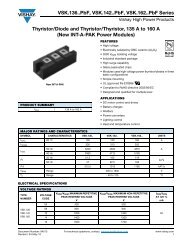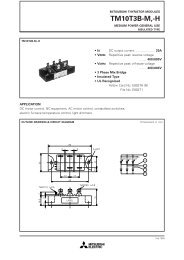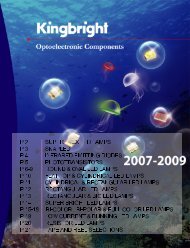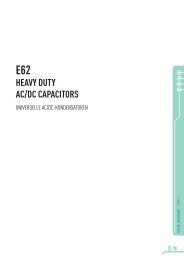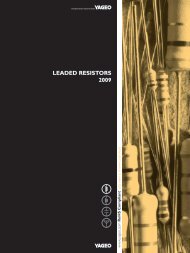1-1 Precautions in Using Aluminum Electrolytic CapacitorsPlease note the following recommendations when use capacitors:1. Electrolytic capacitors for DC applications require polarization .Confirm the polarity before use . The circuit life may be shortenedor the capacitor may be damaged if insert in reversed polarity . Foruse on circuits whose polarity is occasionally reversed , or whosepolarity is unknown , use non-polar capacitors . Also note that theelectrolytic capacitors cannot be used for AC applications .2. Do not apply a voltage exceeding the capacitor's voltage rating.If a voltage exceeding the capacitor's voltage rating is applied , thecapacitor may be damaged by increased leakage current . Whenusing the capacitor with AC voltage do not exceed the rated voltage .8. Cleaning circuit boards after soldering .Halogenated hydrocarbon cleaning solvents are not recommendedfor use in cleaning capacitors supplied with exposed end seals .Where cleaning with a halogenated solvent is desired , capacitorsshould be ordered with an Epoxy-coated end seal .9. Do not apply excessive force to the lead wires or terminals .If excessive force is applied to the lead wires and terminals , theymay be broken or their connections on the internal elements maybe affected . (For strength of terminals , please refer to JIS C5102and C5141 . )3. Do not allow excessive ripple current passing.Use the electrolytic capacitor at current value within the permissibleripple range . If the ripple exceeds the specified value , requestcapacitors for high ripple current applications .4. Ascertain the operation temperature range .Use the electrolytic capacitors according to the specified operationtemperature range . Use at room temperature will ensure a longerlife .10. Keep the following clearance between the vent of the capacitorand the case of the appliance . Do not block the operation of thevent , unless otherwise described on the catalogues or productspecifications . The narrower clearance may adversely affect thevent operation and result in an explosion of the capacitor .5. The electrolytic capacitor is not suitable for circuits which arecharged and discharged repeatedly .If used in circuits which are charged and discharged repeatedly , thecapacitance value may drop or the capacitor may be damaged .Please consult our engineering department for assistance in theseapplications .6. When capacitors have been left unused for long time , use them onlyafter due voltage treatments . Long storage of capacitors tends torise their leakage current levels . In such cases , be sure to providethe necessary voltage treatment before use .7. Be careful of temperature and time when soldering .When soldering a printed circuit board with various components ,care must be taken that the soldering temperature is not too highand that the dipping time is not too long .Otherwise , there will be adverse effect on the electrical characteristicsand insulation sleeve of electrolytic capacitors . In the case of small-size electrolytic capacitors , nothing abnormal will be occurred ifdipping is performed at less than 260ºC for less than 10 seconds .AttentionCase diameterClearanceø 6.3 to ø 16 mm 2 mm minimumø 18 to ø 35 mm 3 mm minimumø 40 mm & up 5 mm minimummerely standard values .Fig.1-1• The description in this catalogue is subject to change without priornotice for product improvement . Therefore , please confirm thespecification before ordering products .• The general characteristics , reliability data , etc ., described in thiscatalogue should not be construed as guaranteed values , they are• Before using the products , please read the notes in this cataloguecarefully for proper use .
1-2 Technical Concepts 1-3 The Function of Electrolytic Capacitors1. The material and structure of Electrolytic Capacitors The electrolytic capacitors could be widely used in appliance (ie. TV , radio ,Electrolytic Capacitor is a simple module . It simply contains an insulatoraudio equipment , watching machine and air conditioner.......etc . ), computerbetween relative conductors in an electrode. The major internal raw material equipment (mother board, image device & the peripherals such as the printer ,contains an element constructed by an separator paper wrap around the drawing device, scanner etc) , communication equipment , estate equipment ,anode foil and cathode foil , which is then impregnated with the electrolyte , measure instrument and also the industrial in strument , air plane , firebomb ,inserted into an aluminum case and sealed.satellite...etc. as a piloting equipment.*According to the inflict electric wave & using purpose , it basically with someclassified purposes as below :1. DC Voltage :a. For Momentary High Voltage : For using to the impulse generator such asthe shock wave resistance test of the heavy electric machine .b. For High Electric Current : For using to the welding machine , X-Rayfacility , copy machine and discharge processing device .c. For DC High Voltage : The electrolytic capacitor and rectifier composing,a special DC high voltage been happened after charged , for using to thepower of electronic microscope and accelerator .d. For Integration & Memory : For either memory circuit or compare circuitinside the calculator .Fig.1-22. Production Processes1. Etching : The process to increase surface area of aluminum foil by usingchemical erosion or chemical corrosion method is called Etching .Normallychemical corrosion method uses the ripple current of electrolyte , combinationof the liquid and temperature to determine the size, shape , and quantity of thedense network of microscopicchannels on the aluminum foil surface .2. Forming : The production process of the anode aluminum foil of electrolyticcapacitors is by anodic oxidation of the etched aluminum foil .The production of the cathode aluminum foil sometimes involvesoxidation in special purposes . This anodic oxidation process iscalled Forming . Boric acid or organic acid is used for high voltageforming and phosphoric acid or ammonium adipate is used forlow voltage forming in order to obtain stable natural oxide layerof Al 2 O 3 .3. Slitting :The cutting of the aluminum foil and separator paper accordingto the required length .4. Winding : The stitching or cold welding of cut anode and cathode foils andtab terminal, and wrap the electrolytic paper in between the anodeand cathode , then fix the end with glue or sticky tape , andattached leads is called the capacitor "element" .5. Impregnation : The process of eliminating the water from the elements bypressurizes or vacuum in order to soak the element with theelectrolyte is called Impregnation . The elements fully filled withelectrolyte is then centrifuged to remove excess electrolyte .6. Assembly : The elements seal with rubber to stop the leakage of electrolytethen slip into a sleeve to form the final product .7. Aging : The purpose of Aging is to repair the oxide film dama ge byrecharging and electrolyte .2. The DC voltage that with alternate ingredient :a. For Wave Filter : Combination with the chip resistor & inductor as a internet,to be past by DC current or some frequency to closure or decli ne someother frequency .b. For Bypass : A parallel track that outside from the circuit element , the IC(integrated circuit) has been rapidly developing in this years and thus aminiaturization or chip of electrolytic capa citors for by pass wasconduced .c. For Coupling : Combination of the electrolytic capacitor , chip resistor andinductor and thus coupling together .d. For Arising of Toothed Wave : Composing of RC charge/discharge circuitthrough the electrolytic capacitor as well as the resistor and a toothed waveto be created by the RC charge/discharge circuit .e. For Reverse (Change) of Circuit : The equipment for change the ACvoltage to DC voltage .3. For AC voltage :a. For Power Improving : Connect the end loading of layout transporting &electrolytic capacitor for power improving .b. For Wave Filter : Prevention of external interference in SCR circuit , usethe LC wave filter circuit to inhibit or erase the interference .c. For Phase Across : Phase change of the inductive electromotor (motor) withsingle phase .




